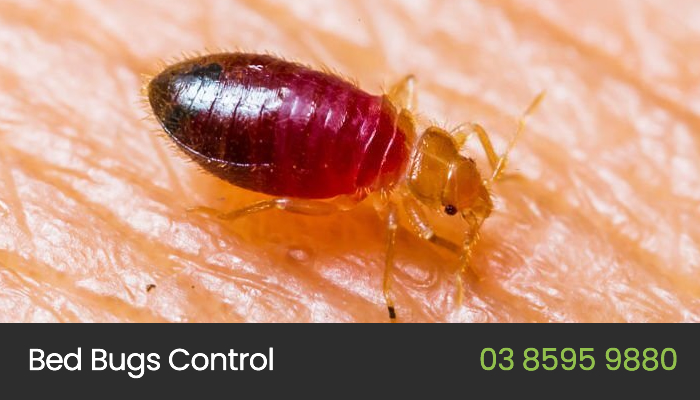Bed Bug Control
Reliable Bed Bugs Pest Control Treatment in Melbourne
Do you see bugs in your bed? Or do you wake up with red itchy bites? These could be signs that tiny bugs are living in your bed or furniture. Bed bugs are very sneaky and hard to find. But they can make living uncomfortable and stop you from sleeping well.
The good news is that you can get rid of bed bugs! Eco Pest Control Melbourne can come to your home and kill the bugs. This stops new bites and lets you sleep peacefully again.
Our Company Uses Safe, Effective Treatments
Our pest control company has helped hundreds of homes in Melbourne with bed bugs. We use safe chemicals and heat treatments that kill bugs but won’t hurt pets or kids. And we know all the hiding spots where they like to live. This means we can get rid of the whole population so the bugs don’t come back.
After treatment, we give tips to help stop bed bugs from ever coming back. Just call us if you see any signs the bugs have returned. We’ll come back and tackle them again for free!
Don’t put up with lost sleep and itchy bug bites any longer.
Call our friendly team today for a free inspection and quote.
We serve all over Melbourne with fast, effective bed bug treatment services. Let us help you sleep better tonight!
Phone: 03 8595 9880
Why Are Bed Bugs Considered Pests?
They may be tiny, but they can cause big headaches! Here’s why these wingless insects are true pests:
- They feed on blood meal, leaving itchy welts and causing discomfort as you try to rest. Some people even have allergic reactions to bites.
- A bed bug infestation can quickly grow out of control since a single female lays hundreds of eggs in her lifetime. This means the population keeps increasing.
- Bed bugs are great at hiding in tiny crevices and cracks in furniture, floorboards, and bed. So they’re difficult to find and treat.
- While they don’t spread disease, they can cause mental health impact, anxiety, and sleep deprivation with their persistent nightly bed bug bites.
- Frequent travel, buying used furniture, and living in crowded housing raise your risk of getting bed bug. But proper inspection and treatment can keep them away.
- Common bed bug (Cimex lectularius)
- Tropical bed bug (Cimex hemipterus)
As you can see, bed bugs aren’t just a nuisance – they can negatively impact quality of life. That’s why it’s so important to get an infestation under control right away with our licensed pest management technicians.
Signs Of Bed Bug
Wondering if those mysterious bite marks and blood spots mean you have unwanted bed bug guests? Here are the top signs an infestation may be lurking:
- Wake up with red, swollen, itchy bed bug bites, especially on areas like your arms, neck, and face that were exposed. They often appear in a line or cluster.
- See dark blotches on your sheets or mattress from crushed bed bug or their excrement. Blotches may be red from your blood.
- Notice a sweet, musty smell in the air. This is from the bugs’ scent glands.
- Catch a glimpse of tiny, flat, brownish bugs scurrying away and hiding when you approach the bed. They’re about the size of an apple seed.
- See tiny white eggs or empty eggshells, which look like translucent skins, in crevices and cracks.
Call us for affordable bed bug treatments if you see these indications.
How We Treat Bed Bugs
Getting rid of sneaky, biting bugs takes proven pest control methods carried out by experts. Here is a step-by-step look at how we tackle bedbug infestations:
1. Inspection
First, a trained technician completes a thorough inspection of your mattresses, bed frames, carpets, baseboards, furniture, and other areas. We use flashlights, detection tools, keen eyes, and more to find all bed bug and eggs.
2. Treatment
We use targeted, effective pesticides and treatments to quickly kill bed bugs and eggs on contact. Treatment plan is done in one visit when possible or over repeat visits for heavy infestations. We focus on spaces where you rest like tufts, seams, and cracks.
3. Containment
We vacuum dead bugs and use containment measures so bugs don’t scatter or crawl away into new hiding spots between chemical treatments. This keeps the population in check.
4. Advice
Our technicians educate you on prevention tips to keep bed bug from coming back once your home is clear. Tips range from encasing mattresses to unpacking carefully after trips.
5. Guarantee
We provide a satisfaction guarantee with follow-up treatments if needed. We want you sleeping soundly!
This integrated pest management approach works to safely, efficiently eliminate bed bug problems at the root cause.
How To Prevent Bed Bugs : DIY Bed Bug Control Tips
Use these pro tips to keep the biting pests away:
- Carefully inspect and wash all secondhand furniture, bedding, and clothing using hot water before bringing them home. Bed bug loves hitching rides into new home environment.
- Thoroughly check luggage after trips and immediately launder all clothing items once home. Bed bug lurks in hotels and can latch onto your stuff.
- Use protective mattress and box spring covers that zip shut and trap bugs inside. This also lets you spot bed bugs easily.
- Reduce bedroom clutter like stacks of papers and cardboard that provide ideal hiding spots for the bugs.
- Vacuum crevices in bedroom furniture frequently using attachments to suck up hiding bugs. Empty the vacuum immediately after into a sealed bag.
- Inspect the perimeter of your mattress seams for signs of infestation on a regular basis. Catch bugs early before populations explode.
FAQs
How common are bed bugs in Melbourne?
They can be found year-round in homes and hotels in Melbourne. However, infestations are not extremely widespread. Being vigilant and contacting bed bug control experts at any early signs can help keep bugs from establishing a foothold.
What temperature kills bed bug instantly?
Exposing bed bug to temperatures of at least 45°C (113F) for over an hour will kill all their life stages, including eggs. Professional treatments by pest control technicians can raise bedroom temperatures high enough to instantly kill bugs.
What time of year are bed bugs most active?
Adult bed bugs feed on human blood and bite people mostly during the night. So their peak time for activity and feeding is usually between about midnight and dawn when hosts are in bed. Their activity patterns can shift slightly based on your sleeping habits.
How Much does Bed Bug Control Treatment Cost?
Professional bed bug treatment costs around $500 to $1,000 or more depending on the size of your home and the extent of the infestation. Multiroom homes with large infestations that have spread widely will fall into the higher end of pricing.
Why Choose Us?
- 10+ Years of Experience in Pest Control Industry
- Licensed AEPMA Proud Member
- $20 Million Public Liability Insured
- Local Melbourne Pest Control Business
- Eco-friendly Treatments
- Use Latest Equipment
- 100% Customer satisfaction guaranteed
- Free Quotes and 12-month warranty
Our Locations
We operate and serve residential and commercial customers in need of bed bug pest control service in these main metro Melbourne locations:
- Melbourne CBD
- Eastern Suburbs
- Western Suburbs
- Northern Suburbs
- Southern Suburbs
- Regional Victoria
Contact Us
Have a bed bug issue affecting your home? Contact our expert team today for detailed inspections, quotes, and prompt bed bug treatments.
Phone: 03 8595 9880
Email: info@ecopestcontrolmelbourne.com.au




